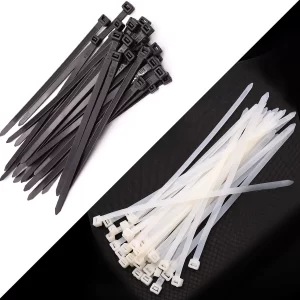- WhatsApp: 8613777772066
- Email: [email protected]
When it comes to securing cables, organizing wires, or even handling heavy-duty bundling in industrial applications, nylon cable tie is the go-to solution. They’re versatile, strong, and easy to use. But how do they work? What makes them so durable? Which type should you choose for your specific needs? Let’s break it all down in this comprehensive guide.
A nylon cable tie, also known as a nylon tie, nylon tie wire, or nylon plastic tie, is a fastener made of durable nylon material. It consists of a flexible strap with serrations on one side and a locking mechanism in the head. This design ensures a secure grip when the tie is looped around objects and tightened.
Nylon cable tie is widely used in electrical installations, automotive industries, construction, and even household applications. Their ability to keep things neat and organized makes them indispensable.

Why is nylon cable tie so popular? Here are some standout features:
High tensile strength – Can withstand significant force without breaking.
UV resistance – Some types are UV stabilised for long-term outdoor use.
Temperature Resistance – Engineered to perform in extreme heat and cold.
Chemical Resistance – Withstands oils, lubricants, and various chemicals.
Versatility – Comes in diverse sizes, colors, and designs for multiple uses.
Ease of Use – Features a self-locking mechanism for quick, simple installation.
Nylon cable tie function with a self-locking mechanism. Here’s how they work:
Nylon cable tie come in different materials, each with unique properties suited for various applications.
Most cable ties use nylon 66, which meets the UL 94V – 2 flammability rating, ensuring industry safety compliance.
High strength and flame-retardant properties.
Operating temperature: -40°C to 85°C.
Slightly more flexible than Nylon 66.
Lower melting point but excellent chemical resistance.
Lightweight and chemical-resistant.
Best for acidic or chemical-rich environments.
High flexibility but lower strength.
Used for temporary fastening.
High impact resistance.
Suitable for extreme environments.
Reinforced for high strength.
Best for heavy-duty applications.
Choosing the right nylon cable tie standard size is crucial. Sizes vary based on length, width, and tensile strength.
| Length | Width | Tensile Strength |
| 4″ | 2.5mm | 18 lbs |
| 8″ | 3.6mm | 40 lbs |
| 12″ | 4.8mm | 50 lbs |
| 14″ | 7.6mm | 120 lbs |
| 20″ | 9mm | 175 lbs |
For heavier applications, consider heavy-duty nylon cable tie with strengths up to 485 lbs.
There are multiple types of nylon cable tie, each designed for different uses:
7.1 Self-Locking Nylon Cable Ties – Standard, easy to use, and reliable.
7.2 Nylon Coated Stainless Steel Cable Ties – For high-temperature and corrosion-prone environments.
7.3 Reusable Nylon Cable Ties – Features a release mechanism for multiple uses.
7.4 UV Resistant Nylon Cable Ties – Ideal for prolonged outdoor exposure.
7.5 Heavy-Duty Nylon Cable Ties – Higher tensile strength for industrial applications.
7.6 Standard Nylon Cable Ties – Common for household and general electrical use.
7.7 Adjustable Nylon Cable Ties – Allows flexibility in bundling sizes.
7.8 Beaded Nylon Cable Ties – Reusable and easy to release.
7.9 Coloured Nylon Cable Ties – Used for identification and organisation.
Nylon cable tie hsa a tensile strength ranging from 18 lbs to 485 lbs, depending on:
Material – Reinforced nylon ties have greater strength.
Width & thickness – Wider ties hold heavier loads.
Locking mechanism – Metal pawl ties provide extra grip.
Common applications include:
Electrical installations – Bundling wires securely.
Automotive – Managing cables in vehicles.
Industrial settings – Securing pipes and hoses.
Home organization – Tidying up cables and household items.
Construction – Fixing scaffolding and fencing.
To ensure a firm and secure grip, follow these steps:
Wrap the tie properly: Make sure it sits evenly around the objects.
Pull the tail end firmly: Tighten gradually to avoid damaging cables.
Use a tensioning tool: This ensures consistent tightness and prevents over-tightening.
Trim the excess strap: Cut off the excess length close to the locking head for a neat finish.
There are several ways to remove nylon cable tie, depending on whether they are reusable or not:
For standard ties – Use scissors, wire cutters, or a knife to cut the tie.
For reusable ties – Press the release latch and pull the tail out gently.
Alternative method – Insert a small flat-head screwdriver under the locking tab and lift it slightly to release the grip.
Indoor use: Up to 10 years.
Outdoor (UV exposure): 1-2 years unless UV-stabilised.
Extreme conditions: Use heat or UV-resistant ties for longevity.
| Feature | Nylon Cable Ties | PVC Cable Ties |
| Strength | High | Lower |
| UV Resistance | Available | Poor |
| Heat Resistance | Good | Limited |
| Flexibility | Medium | High |
| Common Use | Industrial, Electrical | Light-duty, Temporary Fixes |
Whether you need nylon cable tie for industrial use, electrical installations, or home organization, choosing the right type and size ensures a secure and long-lasting hold. Explore our full range of nylon cable tie to find the perfect fit for your needs.
Privacy Policy | Sitemap
Copyright BOESE Co.,Ltd SUPPORT BY :JUNJ